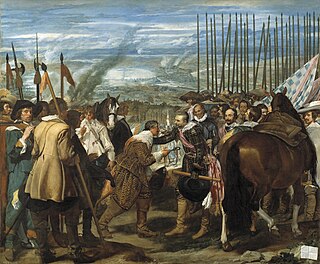 W
WMilitary art is art with a military subject matter, regardless of its style or medium. The battle scene is one of the oldest types of art in developed civilizations, as rulers have always been keen to celebrate their victories and intimidate potential opponents. The depiction of other aspects of warfare, especially the suffering of casualties and civilians, has taken much longer to develop. As well as portraits of military figures, depictions of anonymous soldiers away from the battlefield have been very common; since the introduction of military uniforms such works often concentrate on showing the variety of these.
 W
WThe Alexander Mosaic is a Roman floor mosaic originally from the House of the Faun in Pompeii that dates from c. 100 BC. It is typically dated in the second half of the century between 120 and 100 B.C. It depicts a battle between the armies of Alexander the Great and Darius III of Persia and measures 2.72 by 5.13 metres. This work of art is a combination of different artistic traditions such as Italic, Hellenistic, and Roman. The mosaic is considered “Roman” based on the broader context of its time and location in relation to the later Roman Republic. The original is preserved in the Naples National Archaeological Museum. The mosaic is believed to be a copy of an early 3rd-century BC Hellenistic painting.
 W
WThe Alexander Sarcophagus is a late 4th century BC Hellenistic stone sarcophagus adorned with bas-relief carvings of Alexander the Great, from the necropolis near Sidon, Lebanon. The work is remarkably well preserved and has been celebrated for its high aesthetic achievement. It is considered the outstanding holding of the Istanbul Archaeology Museum.
 W
WIn Greek mythology, Amazonomachy was one of various mythical battles between the ancient Greeks and the Amazons, a nation of all-female warriors. Many of the myths portrayed were that of Heracles' ninth labor, which was the retrieval of the girdle of Hippolyta, Queen of the Amazons; and of Theseus' abduction of Hippolyta, whom he claimed as his wife, sparking the Attic War. Another famous scene portrayed is that of Achilles' victorious battle against Penthesilea during the Trojan war.
 W
WThe Arts of War and The Arts of Peace are bronze, fire-gilded statue groups on Lincoln Memorial Circle in West Potomac Park in Washington, D.C., in the United States. Commissioned in 1929 to complement the plaza constructed on the east side of the Lincoln Memorial as part of the Arlington Memorial Bridge approaches, their completion was delayed until 1939 for budgetary reasons. The models were placed into storage, and the statues not cast until 1950. They were erected in 1951, and repaired in 1974.
 W
WAssyrian sculpture is the sculpture of the ancient Assyrian states, especially the Neo-Assyrian Empire of 911 to 612 BC, which ruled modern Iraq, Syria, and parts of Iran. It forms a phase of the art of Mesopotamia, differing in particular because of its much greater use of stone and gypsum alabaster for large sculpture.
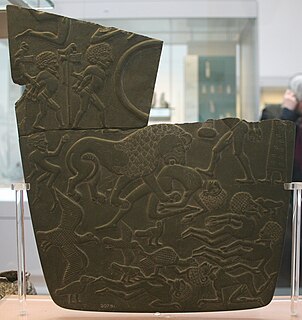 W
WThe Battlefield Palette may be the earliest battle scene representation of the dozen or more ceremonial or ornamental cosmetic palettes of ancient Egypt. Along with the others in this series of palettes, including the Narmer Palette, it includes some of the first representations of the figures, or glyphs, that became Egyptian hieroglyphs. Most notable on the Battlefield Palette is the standard, and Man-prisoner hieroglyph, probably the forerunner that gave rise to the concept of the Nine bows.
 W
WThe Battle of Cascina is a never-completed artwork commissioned for creation by Michelangelo for the Palazzo Vecchio in Florence. He created only the preparatory drawing before being called to Rome by Pope Julius II, where he worked on the Pope's tomb; before completing this project, he returned to Florence for some months to complete the cartoon.
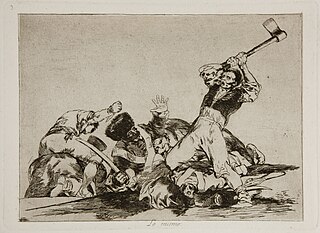 W
WThe Disasters of War is a series of 82 prints created between 1810 and 1820 by the Spanish painter and printmaker Francisco Goya (1746–1828). Although Goya did not make known his intention when creating the plates, art historians view them as a visual protest against the violence of the 1808 Dos de Mayo Uprising, the subsequent Peninsular War of 1808–1814 and the setbacks to the liberal cause following the restoration of the Bourbon monarchy in 1814. During the conflicts between Napoleon's French Empire and Spain, Goya retained his position as first court painter to the Spanish crown and continued to produce portraits of the Spanish and French rulers. Although deeply affected by the war, he kept private his thoughts on the art he produced in response to the conflict and its aftermath.
 W
WThe Dream and Lie of Franco is a series of two sheets of prints, comprising 18 individual images, and an accompanying prose poem, by Pablo Picasso produced in 1937. The sheets each contain nine images arranged in a 3x3 grid. The first 14, in etching and aquatint, are dated 8 January 1937. The remaining four images were added to the second printing plate later, without use of aquatint, and dated June 7, 1937.
 W
WThe Dying Gaul, also called The Dying Galatian or The Dying Gladiator, is an ancient Roman marble semi-recumbent statue now in the Capitoline Museums in Rome. It is a copy of a now lost sculpture from the Hellenistic period thought to have been made in bronze. The original may have been commissioned at some time between 230 and 220 BC by Attalus I of Pergamon to celebrate his victory over the Galatians, the Celtic or Gaulish people of parts of Anatolia. The original sculptor is believed to have been Epigonus, a court sculptor of the Attalid dynasty of Pergamon.
 W
WThe Ludovisi Battle sarcophagus or "Great" Ludovisi sarcophagus is an ancient Roman sarcophagus dating to around AD 250–260, found in 1621 in the Vigna Bernusconi, a tomb near the Porta Tiburtina. It is also known as the Via Tiburtina Sarcophagus, though other sarcophagi have been found there. It is known for its densely populated, anti-classical composition of "writhing and highly emotive" Romans and Goths, and is an example of the battle scenes favored in Roman art during the Crisis of the Third Century. Discovered in 1621 and named for its first modern owner, Ludovico Ludovisi, the sarcophagus is now displayed at the Palazzo Altemps in Rome, part of the National Museum of Rome as of 1901.
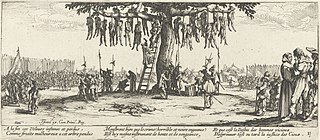 W
WLes Grandes Misères de la guerre are a series of 18 etchings by French artist Jacques Callot (1592–1635), titled in full Les Misères et les Malheurs de la Guerre. Despite the grand theme of the series, the images are in fact only about 83 mm × 180 mm each, and are called the "large" Miseries to distinguish them from an even smaller earlier set on the same subject.
 W
WLeaves from the Theatre of War is the title of a series of 250 ink drawings by Nabil Kanso. The series depicts a long sequence of wide ranging images reflecting satiric tonality and expressions on war and the human tragicomedy. The works were done at various intervals between 1980 and 1992.
 W
WThe Narmer Palette, also known as the Great Hierakonpolis Palette or the Palette of Narmer, is a significant Egyptian archeological find, dating from about the 31st century BC, belonging, at least nominally, to the category of cosmetic palettes. It contains some of the earliest hieroglyphic inscriptions ever found. The tablet is thought by some to depict the unification of Upper and Lower Egypt under the king Narmer. On one side, the king is depicted with the bulbed White Crown of Upper (southern) Egypt, and the other side depicts the king wearing the level Red Crown of Lower (northern) Egypt. Along with the Scorpion Macehead and the Narmer Maceheads, also found together in the main deposit at Nekhen, the Narmer Palette provides one of the earliest known depictions of an Egyptian king. The Palette shows many of the classic conventions of Ancient Egyptian art, which must already have been formalized by the time of the Palette's creation. The Egyptologist Bob Brier has referred to the Narmer Palette as "the first historical document in the world".
 W
WPleven Epopee 1877, more commonly known as Pleven Panorama, is a panorama located in Pleven, Bulgaria, that depicts the events of the Russian-Turkish War of 1877–78, specifically the five-month Siege of Plevna which made the city internationally famous and which contributed to the Liberation of Bulgaria after five centuries of Ottoman rule.
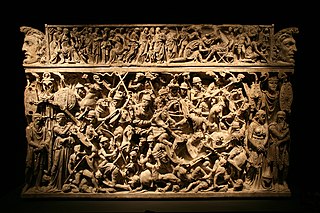 W
WThe Portonaccio sarcophagus is a 2nd-century ancient Roman sarcophagus found in the Portonaccio section of Rome and now held at the Museo Nazionale Romano. Dating to around 180 AD, the sarcophagus was likely used to bury a Roman general killed in the 172–175 AD German-Sarmatic campaign of Marcus Aurelius during the Marcomannic Wars. It is an example of private sculpture of art in the age of Commodus, with visible influences from the design of the Column of Marcus Aurelius.
 W
WStormtroopers Advance Under a Gas Attack is an engraving in aquatint by Otto Dix representing German soldiers in combat during the First World War. It is the twelfth in the series of fifty engravings entitled The War, published in 1924. Copies are kept at the German Historical Museum in Berlin, at the Museum of Modern Art in New York, and at The Minneapolis Museum of Art, among other public collections.
 W
WThe War is a series of 50 drypoint and aquatint etchings by German artist Otto Dix, catalogued by Florian Karsch as K.70 to K.119. The prints were published in Berlin in 1924 by Karl Nierendorf, in an edition which included separate high quality folio prints, and a lower-quality version with 24 prints bound together. It is often compared to Francisco Goya's series of 82 engravings The Disasters of War. The British Museum, which holds a complete set of the folio prints, has described the series as "Dix's central achievement as a graphic artist"; the auction house Christie's has described it as "one of the finest and most unflinching depictions of war in western art".
 W
WTrajan's Column is a Roman triumphal column in Rome, Italy, that commemorates Roman emperor Trajan's victory in the Dacian Wars. It was probably constructed under the supervision of the architect Apollodorus of Damascus at the order of the Roman Senate. It is located in Trajan's Forum, north of the Roman Forum. Completed in AD 113, the freestanding column is most famous for its spiral bas relief, which artistically represents the wars between the Romans and Dacians. Its design has inspired numerous victory columns, both ancient and modern.
 W
WThe USAF Art Program of the United States Air Force was begun in 1950, with the transfer of ~800 works of art from the United States Army. Today the program maintains its headquarters and museum in the NCR.
 W
WIn June 1966, the Army Vietnam Combat Artists Program was established as part of the United States Army Art Program, utilizing teams of soldier-artists to make pictorial records of U.S. Army activities in the course of the Vietnam War for the annals of military history. The concept of the Vietnam Combat Art Program had its roots in World War II when the U.S. Congress authorized the Army to use soldier-artists to record military operations in 1944.
 W
WWars of America is a "colossal" bronze sculpture by Mount Rushmore sculptor Gutzon Borglum and his assistant Luigi Del Bianco containing "forty-two humans and two horses", located in Military Park, Newark, Essex County, New Jersey, United States. The sculpture sets on a base of granite from Stone Mountain.
 W
WWe Are Making a New World is a 1918 oil-on-canvas painting by Paul Nash. The optimistic title contrasts with Nash's depiction of a scarred landscape created by a battle of the First World War, with shell-holes, mounds of earth, and leafless tree trunks. Nash's first major painting and his most famous work, it has been described as one of the best British paintings of the 20th century, and compared to Picasso's Guernica. "Yet it is worth remembering that the picture was a piece of official art and that it first appeared, untitled, as the cover of an issue of British War Artists at the Front, published by Country Life. ... [It] was promulgated in 1917 as covert propaganda for the Allied cause."
 W
WWellington's Victory, or the Battle of Vitoria, Op. 91, is a minor 15-minute-long orchestral work composed by Ludwig van Beethoven to commemorate the Marquess of Wellington's victory over Joseph Bonaparte at the Battle of Vitoria in Spain on 21 June 1813. It is known sometimes as "The Battle Symphony" or "The Battle of Vitoria", and was dedicated to the Prince Regent, later King George IV. Composition stretched from August to first week of October 1813, and the piece proved to be a substantial moneymaker for Beethoven.